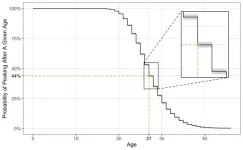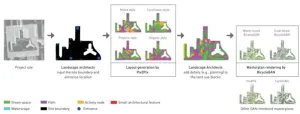(Press-News.org) In a study published in the Journal of the American Geriatrics Society, both chronic and new anxiety were associated with an increased risk of dementia. However, where anxiety had resolved, there was no association with dementia risk.
The study included 2,132 individuals with an average age of 76 years who were participating in the Hunter Community Study in Australia and who were followed for an average of 10 years. The presence of chronic anxiety and new onset anxiety were associated with 2.8- and 3.2-times higher risks of having dementia, respectively. Even higher risks were seen in adults with anxiety before the age of 70 years. People whose anxiety resolved did not have a higher dementia risk than people without current or past anxiety.
“While this sort of question cannot be subject to a randomized controlled trial, this prospective cohort study used causal inference methods to explore the role of anxiety in promoting the development of dementia,” said corresponding author Kay Khaing, MMed, of the University of Newcastle. “The findings suggest that anxiety may be a new risk factor to target in the prevention of dementia and also indicate that treating anxiety may reduce this risk.”
URL upon publication: https://onlinelibrary.wiley.com/doi/10.1111/jgs.19078
Additional Information
NOTE: The information contained in this release is protected by copyright. Please include journal attribution in all coverage. For more information or to obtain a PDF of any study, please contact: Sara Henning-Stout, newsroom@wiley.com.
About the Journal
Journal of the American Geriatrics Society is the go-to journal for clinical aging research. We provide a diverse, interprofessional community of healthcare professionals with the latest insights on geriatrics education, clinical practice, and public policy — all supporting the high-quality, person-centered care essential to our well-being as we age.
About Wiley
Wiley is a knowledge company and a global leader in research, publishing, and knowledge solutions. Dedicated to the creation and application of knowledge, Wiley serves the world’s researchers, learners, innovators, and leaders, helping them achieve their goals and solve the world's most important challenges. For more than two centuries, Wiley has been delivering on its timeless mission to unlock human potential. Visit us at Wiley.com. Follow us on Facebook, X, LinkedIn and Instagram.
END
Can anxiety increase the risk of developing dementia?
2024-07-24
ELSE PRESS RELEASES FROM THIS DATE:
Could Botox make walking easier in children with cerebral palsy?
2024-07-24
A recent randomized clinical trial published in Developmental Medicine & Child Neurology assessed whether injections of botulinumtoxin-A in calf muscles benefit children with cerebral palsy.
“We hypothesized that injections with botulinumtoxin-A in the calf muscles would make walking easier, caused by improved ankle joint functioning following spasticity reduction,” the authors wrote.
In the trial, one botulinumtoxin-A treatment was not superior to placebo in making walking easier (measured as a reduction in energy cost or improved walking capacity); however, there was some evidence of a delayed improvement in energy cost. Moreover, there was some evidence of a decrease ...
How is biodiversity changing in one of the world’s most productive ocean ecosystems?
2024-07-24
In research published in Global Change Biology, investigators examined DNA within ocean bottom sediment cores to assess changes in living organisms within one of the world’s most productive marine ecosystems: the Atacama Trench in the eastern Pacific Ocean, which is located about 100 miles off the coast of Peru and Chile and lies at a depth of up to 5 miles below the surface.
The study is important because ecosystems around the Atacama Trench have been intensively fished and are affected by climate change. Analyses showed a severe drop in biodiversity from 1970 to 1985 that aligns with one of the strongest known El Niño events, as well as extensive fishing efforts in the ...
How does a common skin bacterium cause chronic infections after orthopedic surgeries?
2024-07-24
In individuals who have undergone knee or hip replacement surgery, clinicians are noticing increasing numbers of chronic bone infections linked to a bacterial strain commonly found on the skin. A new study published in the Journal of Orthopaedic Research provides insights into the mechanisms involved.
Utilizing mouse models of bone infection and systematic electron microscopy studies, scientists found that the common skin bacteria Cutibacterium acnes can persist as layers of biofilms for weeks on contaminated titanium or stainless-steel implants. It can also invade ...
Have the burdens of childhood mental health conditions changed over time in England?
2024-07-24
Surveys conducted in England in 1999, 2004, and 2017 have revealed that children with a psychiatric disorder in 2017 experienced more severe difficulties and greater impacts on functioning at school, home, and in their daily lives, compared with children with a disorder in earlier decades. The findings come from a study published in the Journal of Child Psychology and Psychiatry.
The study used data from interviews and questionnaires completed by parents, children (if they were aged ≥ 11 years), and teachers across all 3 surveys.
The increased difficulties found in the study were ...
How to eliminate racial disparities in colon cancer
2024-07-24
A new paper in the Journal of the National Cancer Institute, published by Oxford University Press, finds that eliminating the race disparity in colon cancer testing in the United States would reduce colon cancer, and colon cancer death rates, dramatically among Black people.
Colorectal cancer rates and deaths from the disease have decreased over time, but racial disparities remain and are significant. Compared to White Americans, Black Americans experience higher rates of colorectal cancer incidence and lower survival rates. Black adults are approximately 23% more likely to receive a colorectal cancer diagnosis than White adults. They are also about 31% more likely to ...
Cook like a Neanderthal: Scientists try to replicate ancient butchering methods to learn how Neanderthals ate birds
2024-07-24
It's hard to know what Neanderthals ate: food preparation, especially when it comes to smaller items like birds, can leave few archaeological traces. But understanding their diets is critical to understanding these incredibly adaptable hominins, who thrived for hundreds of thousands of years in wildly varied environments. To learn what food preparation could look like in the archaeological record, scientists tried cooking like Neanderthals.
“Using a flint flake for butchering required significant precision and effort, which we had not fully valued before this experiment,” said Dr Mariana Nabais of the Institut ...
New study finds alarming rise in persistent ‘forever chemicals’ in pesticides
2024-07-24
WASHINGTON — A peer-reviewed study published today in the journal Environmental Health Perspectives has found that per- and polyfluoroalkyl substances (PFAS), known as “forever chemicals,” are increasingly being added to U.S. pesticide products, contaminating waterways and posing potential threats to human health.
The study, Forever Pesticides: A Growing Source of PFAS Contamination in the Environment, is the first-ever comprehensive review of the many ways PFAS are introduced into U.S. pesticide products. Pesticides containing PFAS are used throughout the country on staple ...
At what age do Olympic athletes peak?
2024-07-24
There’s a lot that goes into an Olympic athlete’s quest for gold – years of training and rigour – but also, an athlete’s age. A team of University of Waterloo students used statistics to figure out when an Olympic track-and-field athletes’ peak performance will be.
Track-and-field encompasses running, jumping, throwing, and combined event disciplines. Most athletes’ career performance progressions can typically be visualized as a bell curve, in which they train over several years to reach their best performance, or “peak,” at a ...
Link found between kneecap shape and debilitating joint disease
2024-07-24
The shape of a person’s kneecap could be an indicator of whether they’re more at risk of developing osteoarthritis, according to a new study from The Australian National University (ANU).
According to lead author of the study, Associate Professor Laura Wilson, women who develop knee osteoarthritis often experience more severe symptoms than men, but the reason for this is not well understood. Osteoarthritis, the most common form of arthritis, is a debilitating joint disease that causes pain, stiffness and swelling.
The research team set out to investigate whether kneecap shape might be a contributing factor.
“We wanted to focus on ...
Generative AI tools like Pix2Pix–BicycleGAN are revolutionizing landscape design by enhancing masterplan generation and rendering
2024-07-24
In recent years, the rapid development and enhancement of image generation technologies and mapping tools driven by generative artificial intelligence (AI) have significantly impacted the traditional landscape design industry. Thus, it is pressing for landscape architects to delineate the relationship between image generation and landscape design and explore potential opportunities of practice and research. Research on masterplan generation primarily focuses on “image-to-image” generative adversarial network (GAN). The application of these tools has developed from the generation of architectural floor ...


